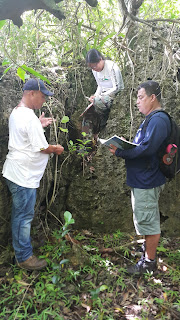Check out this new publication in Micronesica! During the
2017 field season, we caught 3 brown treesnakes (BTS) that had consumed our
fledgling Såli. When we analyzed the physical traits of these snakes, we found
that they were all large individuals in very good body condition, suggesting
that young Såli
(and birds in general) may be a particularly rich meal for snakes that are used
to eating smaller meals of geckos and skinks. In 2018, we caught 12 more BTS
and saw the exact same pattern. In addition, we found that snakes that had
recently eaten fledglings hunkered down in hollow trees for 4-6 days at a time,
presumably to digest their food. These results echo those from a recent study
by Siers et al. (2018), and provide important additional information about
snake behavior and activity cycles – snakes that are full after a large meal
are less detectable and harder to catch. This research (Wagner et al. 2018) was
a collaborative effort between our entire 2017 field crew and is now available here:
(http://micronesica.org/sites/default/files/wagneretal2018.pdf)!
References:
Siers, S. R., A. A. Yackel Adams, & R. N. Reed (2018).
Behavioral differences following ingestion of large meals and consequences for
management of a harmful invasive snake: A field experiment. Ecology and Evolution 8: 10075-10093.
Wagner, C., C. Tappe, M. Kastner, O. Jaramillo, N. Van Ee,
J. Savidge, & H.S. Pollock (2018). First recorded predation of fledgling
Micronesian starlings (Aplonis opaca)
by brown treesnakes (Boiga irregularis)
on Guam. Micronesica 6: 1-7.





















